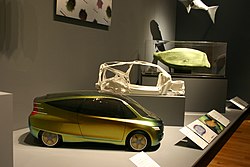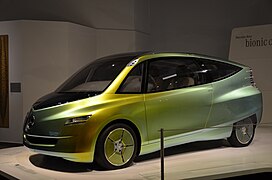Mercedes-Benz bionic car
| Mercedes Benz | |
|---|---|

Bionic car in the Metropolitan Museum of Modern Art |
|
| Bionic Car | |
| Presentation year: | 2005 |
| Vehicle fair: | Innovation Symposium in Washington |
| Class : | Compact class |
| Body shape : | Station wagon |
| Engine: |
Diesel engine : 1.9 liters (103 kW) |
| Length: | 4243 mm |
| Width: | 1815 mm |
| Height: | 1594 mm |
| Production model: | none |
The Mercedes bionic car study was presented at the 2005 Innovation Symposium in Washington .
The vehicle, which is based on box fish , offers space for four people. Based on this, a very aerodynamic and, despite its size, very economical automobile was developed, since the frame is also based on the lightweight construction of the fish. The vehicle is 4.24 meters long and has a drag coefficient of only C w = 0.19. According to Mercedes, the Bionic Car consumes 4.3 liters per 100 kilometers in the EU driving cycle , and at a constant 90 km / h consumption should be 2.8 liters.
According to the manufacturer of the accelerated low-emission 140 hp 1.9-liter turbo diesel with new emission control system at this time h the car in 8.2 seconds to 100 km / and reaches a maximum of 190 km / h.
Series production for the Bionic Car was not planned.
From August to December 2009, the study could be viewed in the Mercedes branch in Cologne as part of a special exhibition. From July 2011 to June 2012 the car was on display in the bionics exhibition at the LWL Museum für Naturkunde in Münster.
Bionic aspects
When developing the bionic car, the first step was to take a closer look at the penguin and examine its extremely streamlined shape. It was noticeable that he hardly lost any speed when swimming. This means that the penguin has very little water resistance. Its drag coefficient is just 0.07, which is very low from the point of view of a car body designer. The developers wanted to transfer these advantages of the penguins to a car in order to be able to drive with as little resistance as possible in order to reduce fuel consumption. In addition to the penguin, other animals were examined more closely, for example the house martin. Like the penguin, this species of bird shows similarly good values for air resistance. These examples from nature have encouraged the company's researchers to investigate other animals. Among other things, they chose the boxfish , which has amazing properties. At first glance, it has little in common with a car. On closer inspection and investigation, however, there are a number of properties that can be transferred to a car: The boxfish lives in coral reefs and lagoons, where in many ways it has the same conditions as cars: it has to move with the lowest possible energy consumption, be agile and move in tight spaces. He also has to protect his body in collisions and withstand high pressure. The prerequisites for this are strong muscles, an aerodynamic shape, a resistant outer skin and good maneuverability. Despite its chunky appearance, the boxfish is a good swimmer. The many edges that the boxfish have have a special function in the coral reefs. Under certain conditions, small water eddies can form in the coral reefs. The boxfish's angular body creates its own small water eddies that counteract the eddies of the ocean currents. The consequence of this is that the boxfish has a stable body position. The fins of other fish cannot counteract such water eddies as well, their stability is much lower. Another advantage of his physique is his aerodynamics. The boxfish can move very quickly with little expenditure of energy. Due to its physique, the boxfish generates very little resistance. Another advantage that results from the low resistance when swimming is the low energy consumption.
For the technical implementation, the developers now had to weigh up possible technical problems that could arise when converting to a car and try to avoid them. The aim was to implement the benefits from nature despite the existing problems. Air resistance measurements were taken using models of cars in the wind tunnel, which were modeled on the shape of the boxfish. The results achieved have been refined and improved again and again. This enabled a bionically influenced, technical further development of an existing biological system to be achieved. Ultimately, the ready-to-drive bionic car developed has a drag coefficient of 0.19. In contrast to other cars, consumption has been significantly reduced. Compared to the Bionic car, the Golf 7 has a drag coefficient of 0.27. This shows that the bionic car is way ahead of other cars in terms of aerodynamics. This is an example of how developers were inspired by a comparison of nature to make a vehicle even more aerodynamic.
literature
- Arno Jambor: Fish on wheels-Bionics in modern automobile design. In: Bionics-Fascination of Nature. MCB Verlag, Munich 2007, ISBN 978-3-939314-10-3 , pp. 276-281.
Web links
- Bionic Car. Daimler AG, accessed on March 5, 2010 .
- Special exhibition Bionic Car. Daimler AG, accessed on March 5, 2010 .
- Bionics exhibition in the Museum für Naturkunde in Münster , the exhibition ended on June 17, 2012, accessed on February 11, 2012




